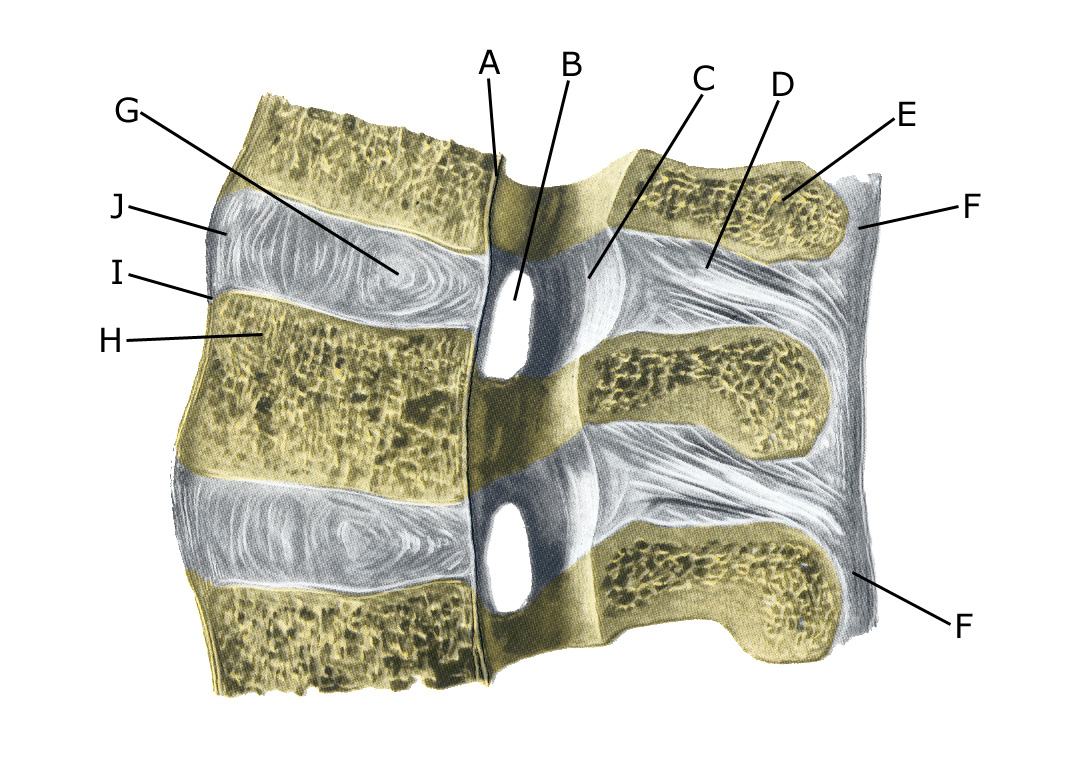Anatomy
The spine is made up of box-shaped vertebrae that are held in place partly by the shape of the bones, partly by ligaments and partly by the large and small back and abdominal muscles. Interspersed between the vertebrae are cartilage discs (disci) that act as shock absorbers. The discs are close to the spinal canal, from which nerves run to the legs.
Back vertebrae
A. Ligamentum longitudinale posteriu
B. Foramen intervertebrale
C. Ligamentum flavum
D. Ligamentum interspinale
E. Processus spinosus
F. Ligamentum supraspinale
G. Nucleus pulposus
H. Corpus vertebrae
I. Ligamentum longitudinale anterius
J. Discus intervertebralis
Cause
If the spine is subjected to a load that exceeds its strength, a tear can occur in one of the cartilage discs, allowing the liquid contents in the centre of the cartilage disc (nucleus pulposus) to squeeze out and press on the nerve root.
Symptoms
Pain and stiffness in the lower back radiating to one of the legs. With a herniated disc, the pain can radiate all the way to the foot. There may be sensory disturbances and loss of strength in the leg. Coughing is often aggravated. In rare cases, the nerves can become so severely pinched that it becomes difficult to control urination and bowel movements, requiring emergency surgery.
Examination
If you suspect a herniated disc, you should contact your doctor, who will be able to determine the diagnosis and what treatment should be initiated. Tests for vertebral tenderness, muscle strength, sensation, reflexes and nerve pressure with radiation are performed, e.g. with a stretched leg lift test (Lasèque test). An MRI scan is often necessary.
Treatment
Treatment includes relief from pain-inducing activity and gradual rehabilitation of the back within the pain threshold. If there are signs of disc herniation without alarm symptoms (difficulty controlling urination and defecation or significant muscle weakness/paralysis), treatment will primarily be aimed at changing the imbalance between the load your back is exposed to and the strength your back is trained to handle.
It is therefore advisable to be instructed (possibly by a physiotherapist) on how to load the back in the most appropriate way and which maximum stressful movements to avoid (‘ergonomic guidance’). It may be necessary to rest for a few days to reduce the pain, but then you should start increasing training with abdominal and back stabilising and strengthening exercises. Exercise is allowed if it does not cause increasing, radiating pain.
Regular 30-minute walks (3-5 times a week) reduces lower back pain and almost doubles the time interval for low back pain recurrence requiring treatment (Pocovi NC., et al. 2024).
If painkillers are needed, paracetamol is recommended, possibly combined with arthritis pills (NSAID). The vast majority of people with herniated discs recover through rehabilitation.
In the event of failure to respond to the above treatment for several months, surgery may be considered, although after 1-2 years there is no clear difference between surgery and rehabilitation.However, in case of alarm symptoms (difficulty controlling urination and bowel movements or significant muscle weakness/paralysis), emergency hospitalisation is advised to assess the indication for emergency surgery.
Especially
Smoking tobacco increases the risk of back pain by reducing the blood supply to the cartilage discs (disci), so everyday injuries don’t heal as well.Smoking cessation is therefore an important part of treatment.
